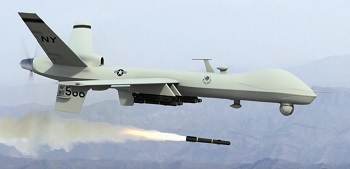Lucky Strike: How Afghanistan’s Historic Ceasefire Was Nearly Shattered
 Michael Hughes
Michael Hughes
June 16, 2018
A U.S. drone operator amid the first ceasefire Afghanistan has ever witnessed decided to launch a projectile into Kunar province to vaporize a morally repugnant Pakistani Taliban leader. The point, however, is not whether the mission succeeded or if he on the receiving end of the strike were target-worthy. The point is what was at stake. The point is what could have happened if the operation had gone awry.
On Friday, June 15, Afghan President Ashraf Ghani in a Twitter post announced that Tehrik-e-Taliban Pakistan (TTP) chief Mullah Fazlullah was dead. Tolo News earlier reported, citing defense officials, that Fazlullah was killed in a U.S. drone strike at 2:30 a.m. local time on Wednesday.
“I spoke with Prime Minister of #Pakistan Nasirul Mulk and Chief of Army Staff General Qamar Javed Bajwa and confirmed the death of Mullah Fazlullah,” Ghani tweeted. “His death is the result of tireless human intel led by #Afghan security agencies.”
The strike came less than a week after Ghani declared a weeklong ceasefire would go into effect on June 11. The Taliban shortly after announced their own 3-day ceasefire for Eid-al-Fitr, which began on June 15.
On June 7, a State Department official told reporters that during the ceasefire – the one announced by Ghani – U.S and Afghan forces would refrain from conducting “offensive operations.”
On Friday, U.S. Forces-Afghanistan spokesman Lieutenant-Colonel Martin O’Donnell told Tolo News that despite the June 13 strike the United States would continue to adhere to the Afghan government’s “unilateral” ceasefire. And then he added certain conditions.
“The cease-fire does not include U.S. counterterrorism efforts against IS-K [Islamic State-Khorasan], al-Qaeda, and other regional and international terrorist groups, or the inherent right of U.S and international forces to defend ourselves if attacked,” O’Donnell said.
U.S. chieftains and the Ghani administration can try and hide behind legalese – they killed a member of the Pakistani Taliban – not the Afghan Taliban. The Pakistani Taliban, unlike their Afghan brethren, after all, are listed as a foreign terrorist organization by the United States.
Not to mention, strictly speaking, the Taliban agreed that the ceasefire would begin on June 15. The U.S. military could argue that the strike occurred on June 13.
And let us not forget who was killed here, they might argue. Fazlullah has been accused of orchestrating an attack in Peshawar that killed 151 people, including 130 children, and ordered the attempted assassination of women’s rights defender Malala Yousafzai. Assuming this is all true, perhaps no one need shed any tears over his demise.
However, even if all of this is true, it does not excuse the Pentagon and Kabul’s reckless decision. First of all, to argue about the dates would certainly be splitting hairs especially considering the United States swore to refrain from offensive operations during the Ghani-announced ceasefire – which began on June 11. At a minimum, it would be a perfect example of not abiding by the spirit of an agreement.
In terms of whether the Taliban member was of the Pakistani or Afghan stripe is missing a larger point. What if the Afghan Taliban or any other Afghan natives took offense? Pakistan has repeatedly accused Kabul of allowing Fazlullah to roam free on Afghan territory (which of course is quite ironic given the hospitality Islamabad has afforded the Haqqani Network). Hence, it is reasonable to believe Fazlullah had some connections and support among some native Afghans.
Moreover, the history of strikes gone wrong should have ruled it out from the word go. The ceasefire would crumble in the blink of an eye if an errant strike led to civilian casualties. Certainly Ghani should understand the potential blowback of such a development and its implications for the truce.
And, as Anisa Shaheed of Tolo News wisely points out, the Mullah is apparently another one of these targets with nine lives.
“This is not however the first time reports have emerged of the death of Fazlullah after the elusive chief of the banned group was named TTP chief in late 2013,” she wrote.
Although he might very well be dead as a doornail, this was no easy target. The Play-station drone operators sitting in the control room in Nevada better have been 200 percent sure they had the right character because a ceasefire was on the line.
There is an obvious presumption among Afghan politicians and U.S. commentators that it was worth risking the ceasefire to rid the world of such an evil. Yet was Mullah Fazlullah more evil than elements that are now in league with the Afghan government and with the full blessing of the U.S. government? Was this Mullah more target-worthy than the human-skinning war criminal – and current Afghan government ally – Gulbuddin Hekmatyar? I would love to know.
Finally, just because the strike was successful does not mean the U.S. or the Afghan government should ever try another at this juncture because this unprecedented cessation of hostilities is a phenomenon we risk never seeing again.
